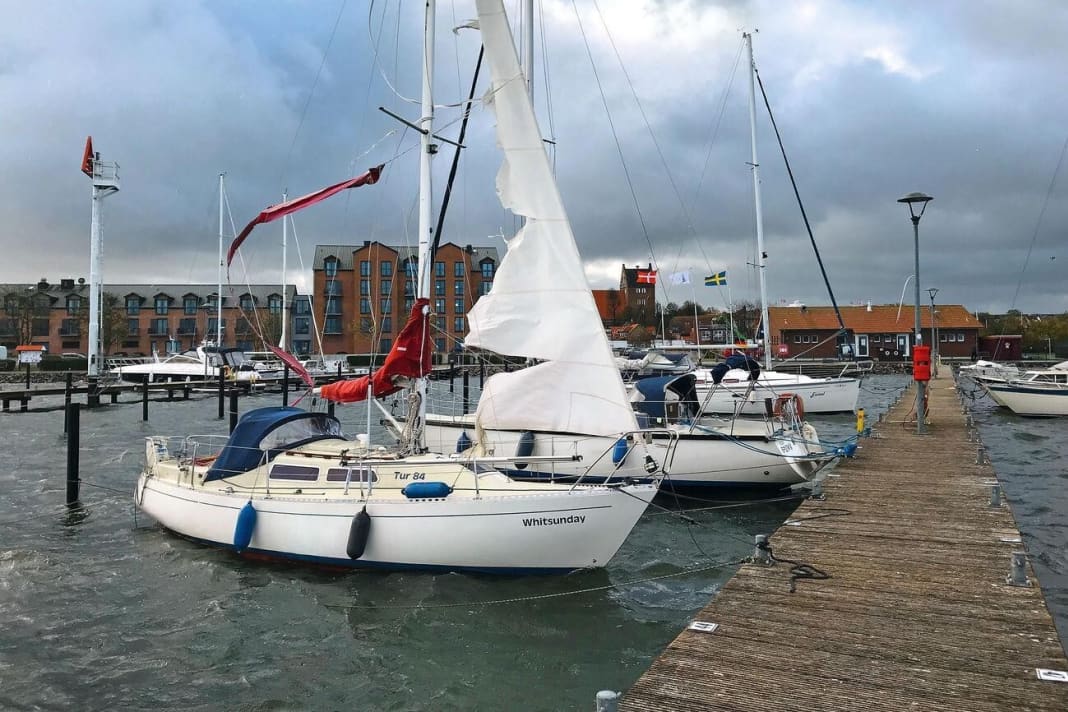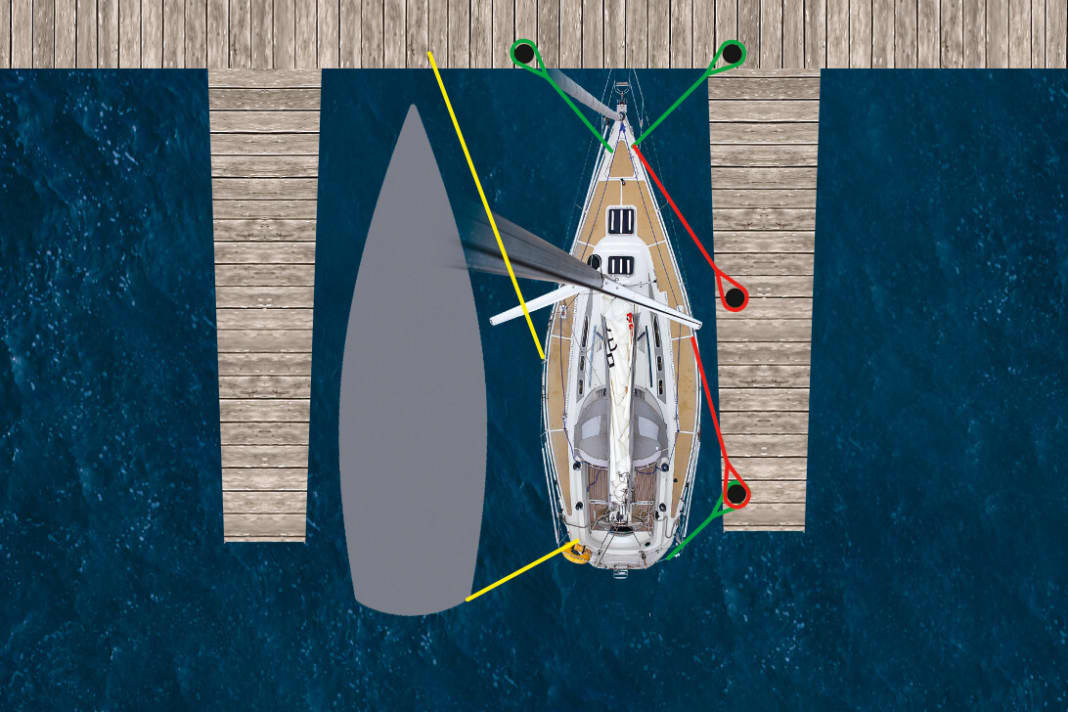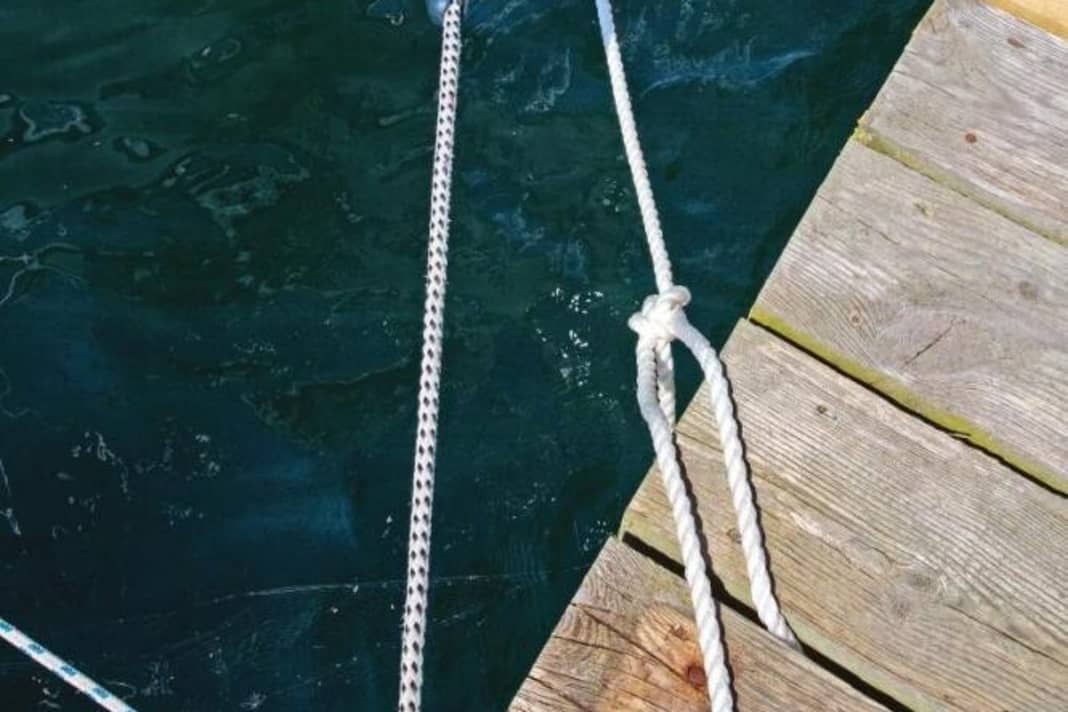





- Protect ship from wind
- Prepare the yacht
- Important: the right mooring lines
- Mooring the yacht safely
- Protect lines against chafing
- Using fenders correctly
- Jolt dampers on the mooring lines
- Mooring to mooring lines or anchor
- Mechanical assistance by motor or winches
- But would you rather anchor?
A yacht should always be prepared as if a strong storm is imminent. After all, you never know whether a devastating storm will suddenly blow up between two sunny weekends. It is risky to react only when strong winds or more have already been forecast. Especially if you have a long journey or other commitments, it can be impossible to react in time. And even if the crew is present, nobody wants to try to squeeze an extra fender between the side of the boat and the pier at night when the wind is howling. It's easier to moor the boat in daylight, with calm and a clear head.
However, a look around most harbours clearly shows that many boat owners are deceived by the supposed safety of a sheltered harbour. Old and worn mooring lines, lines on board and flapping sails are part of everyday life.
The wind is not even the biggest problem. A swell in the harbour basin can also cause the ship to pull on the mooring lines until the cleats give way. Cracks originating there are usually an indication of inadequate mooring.
Many harbours offer better or worse sheltered corners and places from strong winds and storms. If you are lucky and the harbour is not overcrowded, it is often worth asking for a more suitable spot if a storm is forecast. Many harbour masters are very helpful here with their precise knowledge of the harbour, as it is not always immediately obvious where the swell will work its way into the harbour basin. This sometimes creates an invisible undertow right into the innermost part of a harbour, which then pulls at the boats and can be really unpleasant.
Protect ship from wind
If you are already expecting a storm, you should choose your berth accordingly. If there is enough space available, a change of jetty is a good idea. The boats of your neighbours are always an incalculable risk if they are not moored correctly. It is therefore important not only to secure the boat carefully yourself, but also to check on your neighbour's boat and point out any negligence. If the neighbour is not on board or cannot be reached, inform the harbour master. Apart from the owner, only the harbour master is authorised to do anything to the yacht - never do anything yourself if one of the other two can do it. In the event of damage, this can otherwise lead to considerable claims, as nobody can prove who was ultimately at fault if a yacht has broken free.
Only if there is an immediate threat of danger and no other help is possible, which may be the case in a sudden hurricane, may third parties carry out safety measures on other yachts.
If a lot of wind is forecast, it is a good idea to lower the furling genoa, especially before an absence. This not only reduces drag, but also prevents the sail from unrolling and being damaged. In any case, the headsail should be furled so far that a few turns of the sheet are still wrapped around the sail. Then pull the sheet tight to prevent the forestay from vibrating.
If the sail is stowed properly, the absence of the sheet can also cause resonance on the forestay. This vibration, which is very damaging to the rig, can be avoided by pulling the upper furler with the halyard up to about three metres above deck and attaching a line to the mast.
If a lot of wind is expected, biminis, spray hoods and cake stands should be folded up or - preferably - removed completely, as they act like sails and can cause a lot of damage or be damaged themselves.
If the boats roll from port to starboard in the harbour basin, care must be taken to ensure that the masts do not bang against each other. This is especially true when moored in packets. In strong winds, the boats can roll so much on the jetty that it may be necessary to move the masts towards each other, even if the boats are well apart.
In some areas, Sahara sand is also carried along with the wind. These red, tiny grains of sand not only colour the sails brown, but also tend to creep into mechanical gears such as winches or furling systems. In such cases, the sails should be struck and the winches and furling systems covered to protect them. Boats with furling mainsails should then be moored with the bow in the wind so that the Sahara sand cannot get into the mechanics in the mast.
Also interesting:
Prepare the yacht
Unsecured equipment can be damaged by violent movements of the yacht itself or damage your own or other boats. Therefore, stow and secure everything that is not nailed down






Important: the right mooring lines
Enormous forces act on ropes and fittings during storms. In addition to incorrect mooring, material failure is a common cause of hurricane damage. All mooring lines must therefore always be checked for defects and fatigue before a storm. The upcoming loads on the rigging can usually be better distributed with household remedies and sharp-edged abrasion points can be repaired in advance. The most important role in preparing for strong winds is played by the mooring lines, which are designed to hold the yacht in place.
Old halyards, sheets or other running rigging should never be used as mooring lines. This is because, unlike mooring lines, this cordage is manufactured in such a way that it contains as little stretch as possible so that the sails can be optimally trimmed. Such lines can only be used as makeshift mooring lines if sufficient shock absorbers have been installed beforehand.
Lines made of UV-resistant plastic, such as polypropylene, are also unsuitable as mooring lines. After just a few years in the sun, they are so weakened that they break easily and are very likely to do so under load, i.e. exactly when you need them most, in strong winds.
Under normal circumstances, four lines are sufficient to moor a yacht properly. Two fore and two aft lines in a box or fore and aft line and fore and aft spring. These four lines hold the boat in all directions. The boat cannot turn or be moved forwards or aft. In strong winds or even storms in the harbour, however, four mooring lines are no longer enough. This is because the forces must then be distributed over as many cleats and lines as possible.
Cleats and winches
It is not only important to trust the cleats on land. The robustness of your own cleats should also be known, as the boat can have cleats mounted in very different ways. The size of the cleat says nothing about its mounting strength. This only becomes apparent when you look below deck. Some cleats are anchored with four huge bolts and large, force-distributing washers. Others may only be bolted down.
The practical midship cleats in particular, if available, are mounted less solidly on many ships than those at the bow or stern. The material thickness of the surface on which the cleats are mounted can also vary greatly.
Not only cleats are suitable for mooring. Winches can also be used very well, as they are usually the strongest anchors in the boat. Mooring lines can be deflected through or around cleats or jibs and led to the winch. The cleat is only subjected to the force required for the deflection. The actual pulling force is provided by the winch. The stronger the deflection, the greater the force on the cleat or hawse. Winches also offer the advantage of being able to pull lines tightly when mooring.
Mooring the yacht safely
When mooring, the principle of "One Rope - One Job!" applies: each line should only have one job. In addition, each mooring line must be able to be individually tied or untied either from shore or from the ship. It is simply unseamanly to attach a long line to a cleat and then use the loose part for further mooring. This is because the upper unloaded head end is there for releasing and fiddling and should not be used as the loaded end of a further deployment.
Another rule of thumb is: it is better to have several shorter ropes than a few long ones. Ropes can be lengthened using two interlocking bowlines or a hunter's bend - a square knot is strongly discouraged. Two lines of different strengths can also be lengthened with a double sheet knot. But nothing beats a large number of ropes of different lengths on board.
Distributing the load means attaching several lines that have the same task, such as several fore or aft springs, but not attaching them to the same points, but distributing the forces over several cleats or winches.
Read also:
Secure mooring
Starting with your own boat: Depending on the jetty, wind direction and length of the yacht, different mooring methods must be used to optimally distribute the forces acting in strong winds (e.g. by crossing the mooring lines). We show four sketches in the photo gallery.
Placing the boat in Abraham's lap means mooring it on as many sides as possible so that it lies like a spider in a web and preferably does not touch anywhere. If you are lucky, there is no ship in the neighbouring box and so, if agreed with the harbour master, a line can be deployed across the neighbouring berth. In some harbours, it is even customary to put guests in two boxes during the low season for precisely this reason.
Lines should not be deployed across a jetty and thus become a tripping hazard. But here, too, necessity knows no bounds and sometimes the bollards on the opposite side of the jetty have to be used.
In this case, the lines should be marked as well as possible with a bright colour or a flag and ideally illuminated at night with the deck light.





Protect lines against chafing
Wherever ropes rub against other ropes or even against concrete, iron or other sharp surfaces, it is important to prevent chafing. Lines chafe extremely quickly. Suitable protection is therefore placed over the rope. This can be an old garden hose or, even better, an old fire hose available from the volunteer fire brigade. Alternatively, you can buy various mooring line protectors from yacht dealers.
In particular, if a line is attached to a cleat and a second line is diverted or passed through the same cleat to a winch or a second cleat, the ropes on the cleat must not touch each other, if possible, without a pubic rope guard in between.






If, on the other hand, a mooring line is passed around a round-moulded stainless steel cleat, it will also move over the foreign material, but this will not damage either the rope or the cleat.
If the rubbing causes an unpleasant squeaking noise, simply apply a few drops of dishwashing liquid to the rope and the "music" will stop. This dishwashing liquid trick also works if the fenders rub against the hull or the pier. Incidentally, a fender covered with a sock is completely quiet by nature.
Placing a mooring line on a slip may be very practical for normal mooring, as the line can then be easily hauled in from on board. In strong winds and storms in the harbour, however, this is not advisable, because the constant movement around a rough bollard on land also causes the line to fray, and the harbour master should always be asked about his storm experience - perhaps he has other tips. Like in the Caribbean, for example, where some harbours have extra sand basins in which yachts are buried upright. They don't need mooring lines either.
Using fenders correctly
If there is a storm in the harbour, all fenders must be deployed. They are of no use in the forecastle. Fenders should be attached where they are needed, primarily amidships: the thinner fenders at the widest point of the ship and then the increasingly thicker fenders aft and towards the bow. This distributes the force more evenly across the fenders. It can therefore make sense to carry fenders of different sizes.
If the wind pushes from the side, the sail area of the bare rig can be enough to heel the boat considerably. If it is pushed against the jetty, the fenders may work their way under the jetty and damage the hull. Or the boat will right itself again and there will be immense pressure on the fender lines, which in turn will pull on the railing. One tip is therefore to attach fenders at different heights so that at least one always remains in the correct position when the boat heels.
The safest way to avoid fenders being pushed under the jetty is to mount them on the land side. Fixed round fenders on the jetty can provide good additional protection, especially in your home harbour. Also good to know: Drooping, elongated fenders roll back and forth horizontally, while round fenders can roll in all directions. Flat fenders do not roll at all, but instead rub against the gelcoat with every movement of the boat and are therefore more suitable for the stern or only in very calm conditions. Sometimes it can pay off to attach an elongated fender horizontally with two lines so that it can roll vertically up and down on a pole, for example.
Pulling on the fenders can damage the railing
Furthermore, fenders should always be fitted with the valve pointing downwards. If the valve gives way to the pressure, it shoots into the water - and not towards the crew like a projectile.
Incidentally, it is not only in strong winds that fenders should always be moored to or at least in the immediate vicinity of the railing supports, so that the downward pull can be absorbed by the supports. If the railing has a side opening, this should remain closed so that the forces exerted by the fenders on the railing wires are transferred to the bow and stern pulpit.
To avoid pulling on the railing altogether, fenders can also be attached to the foot of the railing supports. However, this can cause the fender lines to catch on the toe rail. To counteract this, short stainless steel strips can be attached to the toeboard under the railing supports to protect them.
If you have the misfortune of having to moor to a quay wall with car tyres hanging from it, a fender board that is hung between the tyres and your own fenders can help. A fender board is also helpful if you have to moor next to a pile. It is a wearing part and protects the boat from uneven quay walls, car tyres or piles. Fender boards made of softwood are best because they are light, soft and flexible. There are many instructional videos on the Internet on how to make them yourself.
Fender socks protect the hull
Clad fenders may look snobbish, but they fulfil a very important purpose: small grains of sand or other dirt disappear elegantly into the fender stocking and prevent scratches and dull spots on the hull that can be caused by rotating fenders. Labelled with the ship's name, they can also be returned to the owner if the fender is lost.
Fender socks made of double material provide better protection. Torn fender socks are a sign of hard work and may have to be replaced after a few hard stormy nights. But that's what they're there for.
An alternative to fender socks is a cloth made of tarpaulin material, which - unlike the fender board - is hung between the hull and the uncovered fenders, the so-called fender skirt.
Jolt dampers on the mooring lines
Even a weak swell in the harbour can cause the ship to move roughly. The boat picks up speed with every swell, which then has to be stopped by the mooring lines. This creates enormous forces, which increase the more jerky the movements are. These forces can loosen or even tear out bollards and cleats both on land and on board.
The force acting on the cleat is proportional to both the mass of the ship and its acceleration, which is decelerated. The formula F=m×a from physics lessons applies, i.e. force is equal to mass times acceleration. The mass corresponds to the displacement of the ship. The acceleration is directly related to the distance it takes for the ship to come to a standstill. The longer this distance over which the ship is braked, the lower its acceleration and thus the force acting on its cleats. This braking distance is created by the stretch in the lines and the shock absorbers.
There are several types of shock absorbers, from classic steel springs and wrapped rubber springs to temporary shock absorbers that can be attached and removed as required. They all follow the same principle of breaking under heavy loads or long periods of work and must therefore be secured.
Mooring lines with rubber springs
With the rubber spring, the safety device consists of the line itself, which is looped three times around the rubber sausage. With steel springs, the safety device must be tied separately so that a bond is maintained if the spring breaks.
As many rubber spring models are almost impossible to detach from the line, it is advisable to carry mooring lines with fitted rubber shock absorbers in the harbour especially for stormy days.
Loose shock absorbers should also be on board and can be threaded onto the normal mooring lines if required. The more of them that are placed on the same line, the longer the crumple zone and the softer the damping. There should be three to four per line.
Steel springs only make sense in the home harbour
The steel spring is probably more practical for the home harbour, if at all, and is not particularly suitable for taking on board: It takes up a lot of space, is heavy and rusts. Remember: when shock absorbers break, the line not only becomes blunt at once, but is also stretched and therefore longer!
If piles are used in pits, it depends on the nature of the piles to what extent they are soft and springy or rigid. Long iron profiles covered with plastic tubes that have been rammed into a soft bottom are often soft and springy, while thick wooden poles tend to be rigid. The length of the lines from the poles to the boat also has a considerable influence on the force. The longer the mooring lines, the softer and more flexible they are. If the line is long enough, the lack of shock absorbers can be remedied by attaching a weight to the centre of the line.
Mooring to mooring lines or anchor
If the ship is moored in the harbour at the bow or stern anchor, it must be ensured that it is well dug in. As with free anchoring, a snubber is also used. This is a line fitted with shock absorbers, which is hooked onto the chain with an anchor claw and secured to a cleat on board. This takes the strain off the anchor winch and prevents the anchor gear from breaking away.
In the Mediterranean, yachts are often moored with mooring lines. Thanks to their length for anchoring to the bottom and the elastic material of the cordage, they are usually sufficiently resilient and do not require any additional shock absorbers.
Although the suspension of the shock absorbers protects the cleats, the boat moves back and forth more than usual. It must therefore be moored at a sufficient distance from the jetty. This is particularly true in the Mediterranean, where the distance between the stern and the quay wall should be increased in strong onshore winds. Although a fender can be attached to the stern here, it should not have to be used.
Mechanical assistance by motor or winches
The lines that are attached to the cleats with a head slap may have slipped a little after hours of pulling and must then be re-adjusted. In the home harbour, it is therefore advisable to moor the boat with lines that have been cut to length and have eyes spliced on board, which are passed through the cleat and then slipped over it. Alternatively, a bowline on the cleat is also very low-stretch.
Depending on the dimensions of the yacht, the pressure on the lines can become extremely high in strong winds and make it impossible to pull them tight using physical strength alone. Pushing the boat away from the jetty with muscle power in order to push a fender into the gap or bring it into position is often almost impossible in strong winds. Of course, you can try to quickly tighten the lines to the rhythm of the boat's movement if they sag briefly. But it is not easy. So why not use engine power? Start the engine briefly and apply power in forward or reverse gear with the rudder in the right position, and the line will start to sag and can be pulled tight. If available, a bow thruster can also help to push the boat in the desired direction, quickly tighten the line or push in the fender.
Many anchor winches also have a capstan. This is the winch above the chain wheel, which does not only have to be used for the second anchor, but can also be used very well for mooring in the harbour. This provides an electric winch at the bow. A winch crank is used to release the brake between the chain wheel and capstan so that it can be operated individually.
But would you rather anchor?
With so much stress in the harbour, the question remains: why not anchor? In many areas there are very well protected anchor bays which, depending on the wind direction, provide safe shelter even in strong winds. The important thing here is to understand the weather conditions so that you don't suddenly end up on the leeward side when a front passes and the wind shifts and the waves roll into the bay.
There are also very helpful apps, such as Navily or iBoat, which assess the respective anchor bays in terms of comfort and safety, dynamically and depending on the weather forecast. A Bottom Discrimination Sounder, which is already fitted as standard on some plotters, can be used to scan the bottom for safe sand or clay bottoms. A good anchoring harness, a large schwoj circle and an anchor sail set on the backstay often result in much more pleasant nights than in the harbour, where you have to sleep with the jerking and pulling on the lines.

